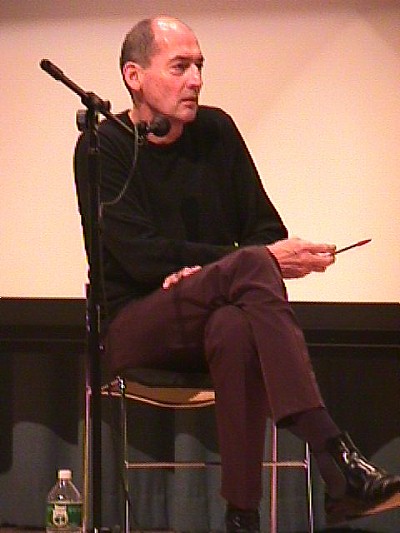1999.12.30
sculpture versus architecture
A quick answer to the series of serious questions raised by Marcus and "Pavilion" is that the notion of hybrid is very much alive in architectural discussions and debates today. Is "Pavilion" clearly a sculpture/architecture hybrid? And if so, are hybrids a 'category' that aesthetics must begin considering?
There are lots and lots of hybrids out there. Yes, the categorization of the hybrid is not easy, and even most times messy, but please let's not ignore the hybrid by simply not seeing it for what it really is.
| |

| |
2003.12.30 16:08
Rem Koolhaas and OMA-AMO
At the In Your Face symposium at NYU 29 September 2001, featuring Robert Venturi, Denise Scott Brown, Rem Koolhaas and others, I questioned Venturi about his unsureness regarding 'content' when it came to building facades that were also screens that present electronic imagery--Venturi pioneered this idea back in the 1960s with an unexecuted design for the Football Hall of Fame. My point was that if architects design buildings where (some of) the facades are screens, that it might also be the 'job' of the architect to provide the content to be 'screened', or at least provide some sort of direction to how the screen facades might be fully utilized. After a full exchange with both Venturi and Scott Brown, the moderator of the symposium asked Koolhaas if he had any additional thoughts on this topic, to which Koolhaas replied, "I am not interested in discussing 'content'." Koolhaas has since then obviously changed his mind because the whole theme of the Koolhass/OMA/AMO exhibit presently at Berlin, and the title of Koolhaas' forthcoming book, is indeed Content.
It was soon after late September 2001 that Quondam, a virtual museum of architecture, began defining itself as "architecture as the delivery of content."
| |
2008.12.30 09:00
pragmatists turning political?
context/inspiration
Pier Vittorio Aureli's "Toward the Archipelago: Defining the Political and the Formal in Architecture" (in Log 11, Winter 2008) lays out the context of Alejandro Zaera-Polo's "The Politics of the Envelope" (in Log 13/14, Fall 2008).
within Toward the Archipelago:
Urbs vs. Civitas
Urbanization
Infinity and Enclaves of Urbanization
The Enclave and the Landmark
The Political
The Formal
The Archipelago
Architecture
passages from The Political:
"Politics arises between men, and it is established as a relationship." (Arendt)
The space in-between can only materialize as a space of confrontation between parts. Its existence can only be decided by the parts that form its edges.
In the dual terms of Carl Schmitt, the space in-between is formed by the decision of who is a friend and who is an enemy. This decision does not exist "as found" in between the parts, but arises from the position taken by the parts that form this space.
...the notion of agonism--the counterpositing of parts--functions as a critical mirroring of oneself via the other to the extent that it is possible to say that to make a collective claim of political autonomy, one must first declare one's counterpoint.
The enemy, on the other hand, estranges us from our familiar self-perception and gives us back the sharp contour of our own figure, of our own position. What counters us inevitably constitutes the knowledge of our own limit.
The political cannot be reduced to conflict per se; it indicates the possibility of conflict and as such calls for its resolution. Even if it means slightly confounding the terms of Hegel's dialectic, the political realizes the resolution of conflict not by a synthesis of confronting parts, but by recognizing the opposition as a composition of parts. This suggests that it is possible to theorize a phenomenological and symbolic coincidence between political action and the form of an object.
[This is the space of the politics of the envelope.]
Both deal with the fundamental question of defining the limits that constitute related but different parts. From this vantage point--the question of a composition of parts, the question of limits posed through the knowledge of the other--I propose to redefine the concept of the formal.
aggregate base
| |
2012.12.30 13:05
In the future, everything will be a museum.
If ours is "an era of decadent, mass-produced, Orwellian mendacity about everything our culture is or aspires to be," then isn't that what our architecture should reflect?
Quondam, you believe that is what architecture should reflect?
Other than that, I don't find that decadent need be strung along with the other words. And iI don't know whether 'our culture' really aspires to be anything..No, even, perhaps 'our culture' aspires to be what it is not now and what it seems destined to be... So there is the possibility of contradiction in your question.
Of course there is the possibility of contradiction in my question--the contradiction was the point.
The question is mine, but not the quotation.
I believe in multiple choice:
a. Welcome to the Hotel Zeitgeist.
b. In the future, everything will be a Zeitgeist Museum.
c. In the futute, everything will be a museum shop.
d. One museum fits all Zeitgeists. (Period rooms of the world unite!)
e. In the Zeitgeist, everything will be the future.
14123001 Malcolm Reading Guggenheim Helsinki
16123001 Garden of Satire Quondam Neighborhood 001 plans 243ci03
18123001 Junya Ishigami Forest Kindergarten Shan-dong
18123002 Mecanoo.CCDI Three Cultural Centers & One Book Mall Shenzhen
20123001 Vanna Venturi House plan site plan elevations sections 2182i08
20123002 iqq23 plan base model work 2468i122
20123003 GAUA iiq12 schematic model work 2429i400
|
